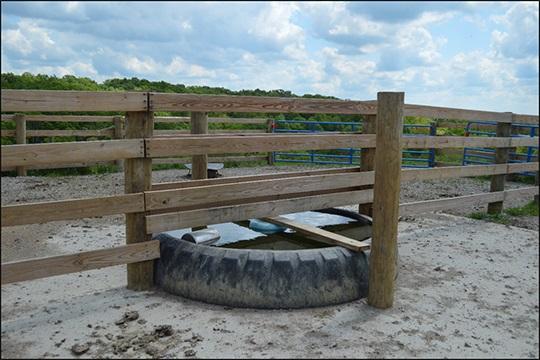Providing Water for Beef in Rotational Grazing Systems with Tire Waterers
By Steve Higgins

Despite its importance, water is often the most poorly addressed component of animal nutrition on the farm. It is essential that livestock have easy access to plentiful, clean water within every paddock of a rotational grazing system to realize maximum efficiency and production. Although water may be available to cattle, the sources vary significantly within and among farms. Sources for water on farms range from full access to streams and ponds to city water-fed troughs located throughout the operation. The quantity, quality, and location of the water supplied can greatly influence feed intake, forage utilization and persistence, herd behavior, and manure distribution. Factors, such as relative humidity, type of animal, shade availability, and distance to water, play important roles in determining the water intake rates of cattle.
Location of a watering source is critical. Watering sources can influence grazing, compaction, and manure/nutrient deposition patterns. An optimized rotational grazing system should be designed to provide water so that cattle do not have to travel more than 800 feet to water, if possible. Waterers should be placed on summit positions because a high site should contain well-drained soils. Choose a location that isn’t heavily erodible, to minimize excessive mud and runoff that can pollute nearby water sources.

High volume tire waterer tanks can be utilized to service multiple pastures within a rotational grazing system. Figure 1 illustrates how one tire waterer can serve as a watering hub for multiple pastures. With a large surface area and volume of water available for livestock, tire waterers can provide plentiful, high quality water to multiple animals at once and still have additional volume available for the rest of the herd. These structures can be reliable, high durability, low cost alternatives to traditional limited access watering solutions. Tire waterers can be plumbed with city water, harvested water, or a hybrid of both. A concrete pad or other all-weather surface should be installed around the tank to prevent mud and erosion from developing. If animals are observed getting into the tank, exclude animals with a cross member attached to the top of the tire tank or fence across the structure. Figure 2 illustrates both of these design concepts. Like any waterer, regular cleaning and periodic maintenance will be necessary.
Rotational grazing systems are not effective if water is not readily available to every paddock. If the watering source is of poor quality, improperly located, or a limited resource due to inadequate flow rates and space limitations, then production may become limited. Taking a thoughtful approach to water quality, quantity, and location may help cattle producers achieve their long-term goals of increased production and profitability. For questions or more information regarding providing water in rotational grazing systems with tire waterer tanks, please contact Steve Higgins.
Video: Tire Tanks for Watering Livestock
Categories:
Winter
Animal Management


